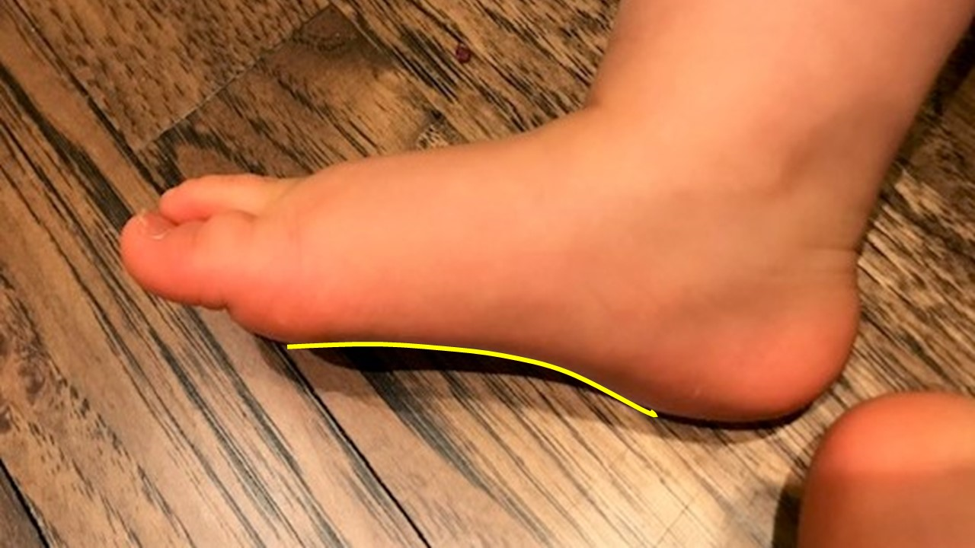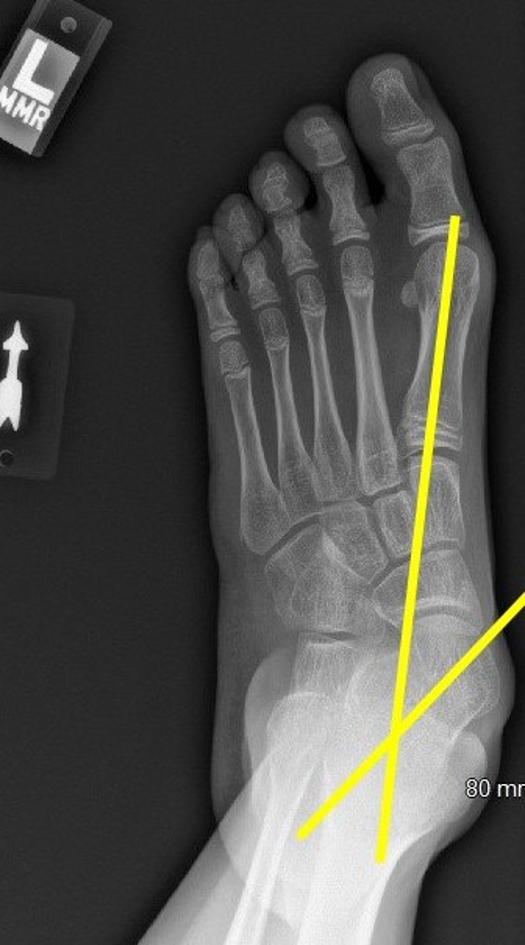Description
Flexible flat feet in children are very common. We say “flexible”, because the arch of the foot disappears when the child is standing but re-appears when the child is sitting or standing on tiptoes (see figures 1a & 1b). Flexible flat feet usually do not cause any pain or problems with walking. Most children with flexible flat feet can participate in sports and gym and wear regular shoes without difficulty.

Figure 1a: With standing, the arch appears to disappear.

Figure 1b: When sitting, appropriate arch formation is present.
Symptoms
Flexible flat feet work just like feet that are not flat. Most children are born with flat feet, and the arch usually develops by the time they are 10 years old. However, there are some children who do not outgrow their flat feet. Even for feet that remain flat into adulthood, they usually do not cause pain or problems with standing, walking, sports participation or work.
Some adolescents with flexible flat feet do have pain along the bottom of the foot. If this happens, an examination and visit with a doctor should be scheduled.
A rigid flat foot means that there is still no arch in the foot, even when the child is standing on tiptoes.
Evaluation & Examination
The doctor will want to know when the flat feet were first noticed, if anyone in the family or your child has a nerve or muscle disease, and how your child has been functioning. He or she will perform a thorough examination of the foot and legs to make sure that your child does have flexible flat feet. Flat feet that are rigid and
not flexible may indicate a more serious problem.
Other Tests
Flexible flat feet can be diagnosed by your doctor with a good examination. Usually, other studies are not needed. However, if the flat feet are causing pain, are rigid, or there are signs of nerve or muscle problems, X-rays or other tests may be ordered.

Figures 2a & 2b: X-rays of a flatfoot. The lines mark the different parts of the foot and show how the foot rotates outward and sags in the middle.

Figure 2b
Treatment
The vast majority of flexible flat feet do not need any treatment, especially if there is no pain. There are no exercises, braces, special shoes, or shoe inserts that will change the shape of a flexible flat foot. Children with flexible, painless flat feet can wear regular shoes and participate in all activities.
If the heel cords (Achilles tendons) are tight and causing pain with activity, heel cord stretches can help. To do a heel cord stretch - stand about 3 steps away from a wall. Put one foot in front and bend that knee. Keep the back knee straight. You can use your hands to support your weight against the wall as you lean forward. Make sure to keep both heels on the ground. Hold for 30 seconds, and then switch legs.

Figure 3: Wall stretch for tight heel cords
Soft shoe inserts to support the arch can also help children and teenagers with arch pain from flexible flat feet. Regular sneakers with built-in arch support can also be used. Studies have shown that inexpensive cushioned shoe inserts bought in a store or a pharmacy off the rack work just as well as expensive custom orthotics or special shoes. Hard, rigid arch supports can actually cause more pain and should be avoided.
In very rare cases, children and teenagers with flexible flat feet will continue to have pain even after stretching and shoe inserts. Some flexible flat feet may become rigid as the child grows. In those cases, consulting with a pediatric orthopaedic surgeon may be needed to see if surgery can help.
Prognosis
Most children with flexible flat feet do not require medical or surgical treatment. They can wear regular shoes and participate in all activities throughout their life. For some children who have pain, soft arch supports can help. Surgery is rarely needed for this condition.
References
Tudor A et al. “Flat-footedness is not a disadvantage for athletic performance in children aged 11 to 15 years.” Pediatrics 2009,;123 (3): e386-92.
More Information
OrthoInfo –
Flexible Flatfoot in Children
American Academy of Pediatrics –
Flatfeet and Fallen Arches
Condition QR Code:

Q. My child has flat feet. When do we need to go see a doctor?
Your child should be evaluated if the flat feet are causing pain, have pressure sores, or if there are areas of rubbing when he or she wears shoes, or if the feet are stiff. The feet should be checked by your pediatrician who may refer your child to an orthopaedist if there are concerns.
Q. What are the chances that my child will grow out of his flexible flat feet?
The chance is about 80-90%. Only 1 or 2 out of every 10 children will continue to have flat feet as an adult. However, many adults with flat feet have no pain, can wear regular shoes, and participate in all activities.
Q. Since some flexible flat feet have pain when children grow, should we treat my child’s flexible flat feet to prevent future problems?
There are no studies showing that the use of arch supports or shoe inserts in children who have no symptoms or pain will prevent future problems. There are no shoes, inserts, arch supports, exercises, or chiropractic manipulations that will make flat feet go away or get better. It is best to just wait and see how your child’s foot develops. A well-fitting, supportive shoe is the best shoe choice.
Q. Are my child’s flat feet going to cause pain during athletics or regular activities?
The vast majority of flat feet have no pain or problems doing sports or just walking around. In fact, many professional athletes, including basketball players, have flat feet.
Q. Will my child’s flat feet prevent him/her from playing sports or joining the military?
No. Most children with flat feet can play sports. It is a myth that you cannot join the military with flat feet.
Q. Are my child’s flat feet the reason why he/she is not coordinated and not a good athlete?
No. Coordination and athletic ability are a combination of genetics, hard work, training, practice, attitude, and skill. Children with flat feet perform equally well at sports as children who do not have flat feet (Tudor A et al. “Flat-footedness is not a disadvantage for athletic performance in children aged 11 to 15 years.” Pediatrics 2009,;123 (3): e386-92.)

 POSNA.org
POSNA.org





